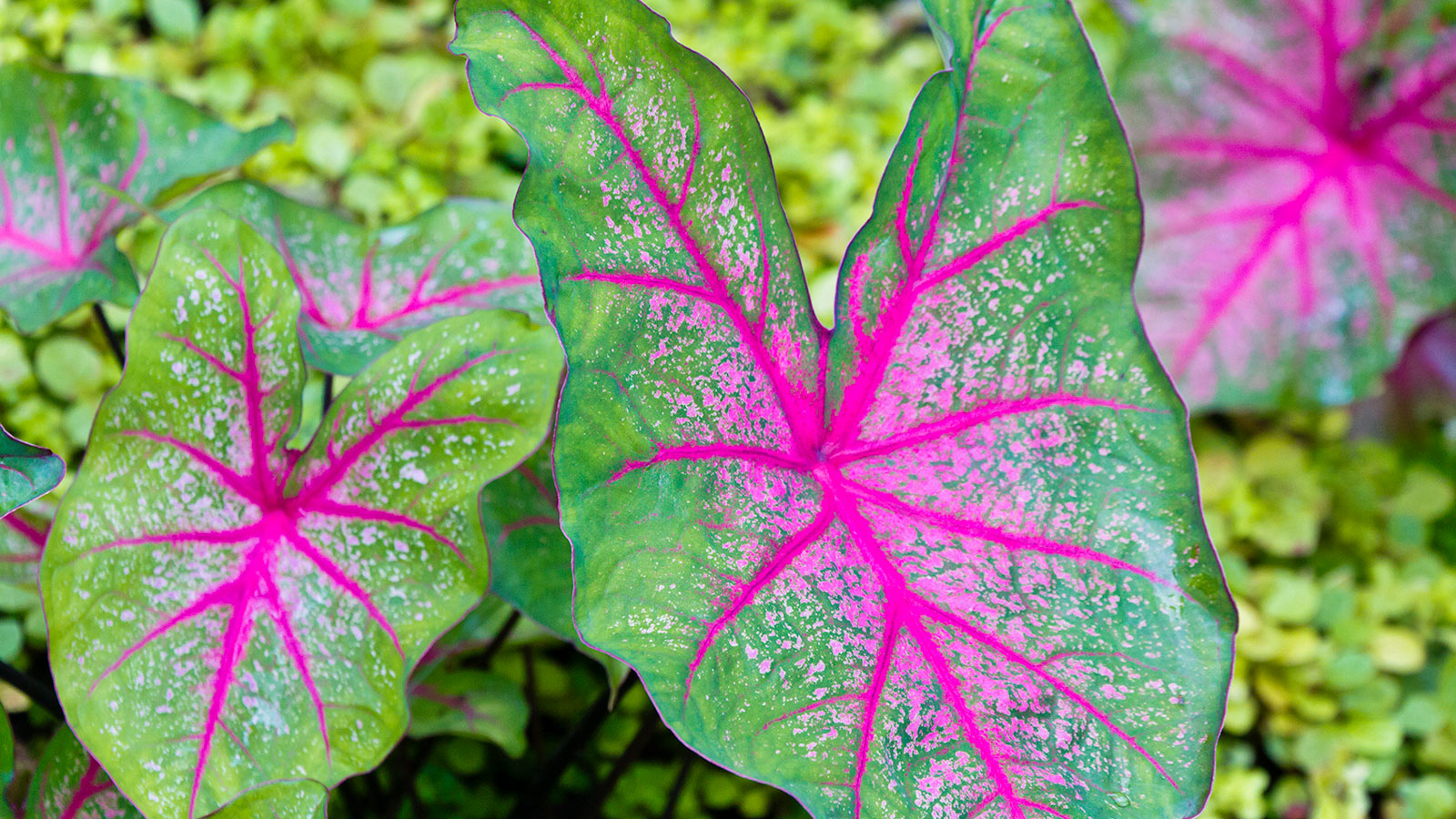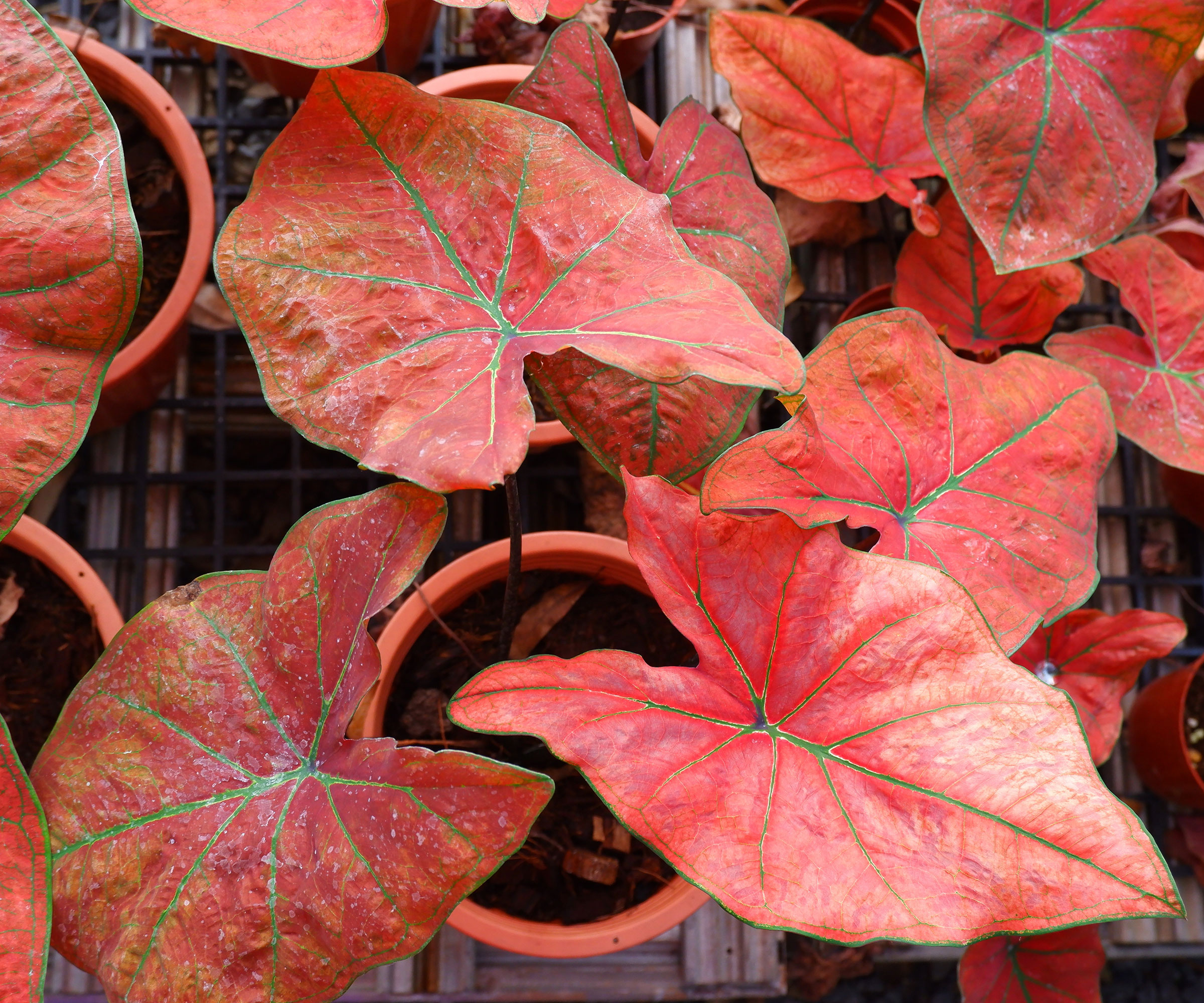Grow Caladiums: Best Care For Elephant Ear Plants
With their dynamic tones and majestic appearance, colorful caladiums are a highly versatile plant and great fun to grow in backyards, borders and container gardens


Sometimes referred to as the ‘heart of Jesus’ plant or elephant ears, caladiums are loved for their impressive ornamental value. Available in a range of vibrant colors and intricately patterned multi-colored leaves, these beautiful plants will thrive within the landscape and can also live happily indoors in containers.
You can grow many varieties of caladiums, both as fancy-leaved or strap-leaved cultivars. Caladiums can be purchased as potted plants or dormant tubers, and their size depends on the variety. Though caladiums are considered easy to grow, they are tropical in origin, so accommodating their special cultural needs will help keep them looking their best.
Quick Caladiums Facts:
- Botanical name – Caladium
- Height – 12-24in (30-61cm)
- Spread – 12-24in (30-61cm)
- Sun exposure – Shade, part shade
- Soil requirements – Well-draining
- Hardiness zones – USDA zones 8-12
- When to plant – Spring, summer
Caladium Care Essentials
Light Conditions:
Proper caladium care requires us to pay special attention to the plant’s light needs. Garden caladiums grow best in beds that receive partial or dappled shade or even full shade through the day. Approximately two-four hours of direct light is more than sufficient to keep them looking healthy and happy. If grown as houseplants, they should be situated near a window where they are able to receive bright, indirect sun throughout the day.
Watering Needs:
Consistent moisture is essential for growing caladiums. Routine irrigation is required in most regions – specifically, in climates that are especially arid. Plants grown in pots or containers also require additional care, since the pots are likely to dry between waterings. Though caladium plants appreciate deep watering throughout the root zone, they are unable to tolerate oversaturated soils or those with poor drainage.
Temperature & Humidity: Caladium plants are a good choice for landscaping in regions with frequent heat and humidity, and they grow best through the warm seasons. The arrival of cooler temperatures in fall is a time of transition as the plant gradually begins its preparation for winter. Caladiums grown as houseplants also need to be kept warm. Indoors, potted plants should always be kept safe from drafts or vents. Frequent misting may also be needed to help maintain proper humidity levels.
Soil & Compost: Caladiums can be grown under a wide range of soil conditions, including various potting mixes. As noted, good drainage is of the utmost importance. Adequate drainage plays a key role in the plant's overall health, as well as the prevention of certain diseases. As caladiums prefer soils that are nutrient-rich, fertility can also impact how the plants grow.
Fertilizer: Feeding needs of caladium plants vary, depending upon the garden. Growers with poor soil often suggest fertilizing the plant on an annual basis. Soil amendment with a high-quality compost at planting time is beneficial and will help new tubers establish more quickly. Though frequent feeding will result in lush foliage, you might see a loss of color or pattern in the caladium’s leaves if there are excess nutrient levels in the soil.
Sign up for the Gardening Know How newsletter today and receive a free copy of our e-book "How to Grow Delicious Tomatoes".

How and When to Plant Caladium Bulbs
You are most likely to obtain caladium tubers in spring. Before planting caladium bulbs, make certain that all chances of frost have passed and that the soil has warmed. You can continue planting caladiums throughout the season until mid-summer.
- Plant caladium tubers 1.5-2in (4-5cm) deep, with their eyes facing up. This may sometimes be difficult to distinguish in some varieties. Those that are planted upside down will still emerge, but more slowly.
- Space your caladiums about 4-6in (10-15 cm) apart.
- For an early start to the season, pre-sprout tubers indoors in trays or containers four to six weeks prior to the region’s last frost date. In the spring, they can be moved outside after a brief hardening-off period.
- If you plan to grow caladiums as houseplants, start in the same manner.
Caladium Propagation
Propagate your favorite varieties of caladium through division. To multiply your plants, dig them from their beds and remove any excess soil. This should be done while the plant is dormant.
Each tuber should have a larger central part that is surrounded by smaller segments. Segments can be carefully cut into multiple new plants, provided each piece has at least one viable eye.
Problems, Pests & Diseases
Caladium tubers are prone to rot. This can occur after planting and throughout winter storage. Rot is the direct result of exposure to temperatures that are too cool or when they’re exposed to excessive moisture.
As a perennial that likes shade, the plants are also sensitive to light. Receiving too much light may cause signs of leaf scald in which foliage begins to brown and die back.
Overwintering Caladiums
Within their hardiness zones, caladiums will overwinter outdoors. But, in colder regions, since they are considered tender perennials, you need to protect them to ensure their healthy return to the garden. Garden caladiums can be dug and potted into containers with the arrival of fall. Once indoors, continued caladium plant care is needed until spring if growing as a houseplant.
Outdoor plants will naturally begin to go dormant. When the caladiums’ foliage begins to collapse and turn yellow, carefully lift the plants with their attached tubers from the ground using a garden fork. When they have dried out for at least a couple weeks, cut off the foliage. Place the tubers in a netted bag or box and cover them in dry peat moss or similar. Store the dried tubers in a warm, dark place for the duration of winter.

Frequently Asked Questions
Are Caladiums Perennials?
Caladiums are considered perennial in USDA zones 8-12. Fortunately for those outside of these regions, you can grow the plant in the home landscape as an annual. These tubers are planted outdoors in spring after the weather has warmed. At the end of the growing season, tuberous corms can be removed from the soil and placed in storage for winter.
Can Caladiums Take Full Sun?
In recent years, several new sun-tolerant caladium hybrids have been introduced. Though these plants are often able to withstand much more light than other cultivars, full-sun conditions may be problematic. Sunscald is most common among caladiums that have been planted in beds that receive full, direct sunlight.

Tonya Barnett has been gardening for 13 years. Flowers are her passion. She has transformed her backyard into a cut flower garden, which she regularly chronicles on her YouTube channel http://www.youtube.com/@tonyawiththeflowers.